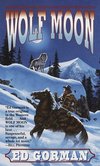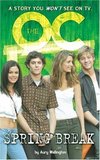I haven’t been reading as much as I would like lately because I’ve been too busy writing, but I have managed to squeeze in a few books…
 I devoured Ed Gorman’s WOLF MOON in one sitting. I really enjoyed it. The book came out a few years ago and it’s unlike any western I’ve read before. Think of it as western noir, with an emphasis on noir, though you wouldn’t know that from the standard "western" cover and "frontier" font. Sure, it takes place in the west and has all the expected genre trappings…but it’s the kind of tale Charles Williams, Harry Whittington, Dan J. Marlowe, Wade Miller, Vin Packer and Charles Willeford like to tell. Dark and violent. Grim and doomed. It’s about a bank robber who gets double-crossed, goes to prison, and seeks revenge. Sounds pretty standard but trust me, it isn’t. The hero of this book is an original…a guy who is literally rabid with revenge. I can’t help but wonder how the book
I devoured Ed Gorman’s WOLF MOON in one sitting. I really enjoyed it. The book came out a few years ago and it’s unlike any western I’ve read before. Think of it as western noir, with an emphasis on noir, though you wouldn’t know that from the standard "western" cover and "frontier" font. Sure, it takes place in the west and has all the expected genre trappings…but it’s the kind of tale Charles Williams, Harry Whittington, Dan J. Marlowe, Wade Miller, Vin Packer and Charles Willeford like to tell. Dark and violent. Grim and doomed. It’s about a bank robber who gets double-crossed, goes to prison, and seeks revenge. Sounds pretty standard but trust me, it isn’t. The hero of this book is an original…a guy who is literally rabid with revenge. I can’t help but wonder how the book
would have fared, and the attention it might have garnered, if it was marketed as a weird twist on a dark crime tale instead of western.
I also read Meg Wolitzer’s THE POSITION, about a couple of sex educators and the impact their JOY OF SEX-esque book has on their children. The book was well-written, clever, funny and insightful and yet, as a whole, unsatisfying and disappointing. I kept waiting for the story to start and it never did. I kept waiting to get involved and I never did. It’s basically a series of loosely connected vignettes without any real narrative drive.
Which brings me to Susanna Clarke’s JONATHAN STRANGE & MR. NORRELL. I’m mid-way through it (pg 390) and so far I am loving it. I find myself so involved in the book that I tote that damn thing with me everywhere (which is no small feat…the book is nearly 800 pages and I have a bum arm) and find any excuse at all to read. I’m sure a thousand folks have said this before me, but I’ll say it again… the book is basically HARRY POTTER for grown-ups. I hope the next 390 pages are as satisfying as the first!




